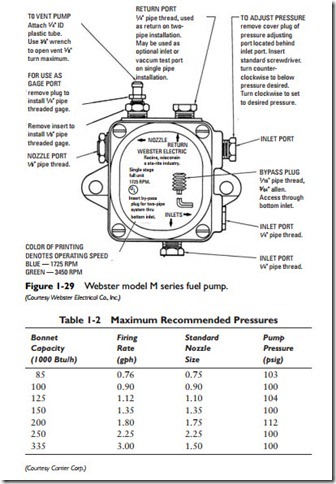Priming Fuel Pumps
On occasion, the oil burner may fail to pump oil. When this occurs, check the oil supply line to the furnace for leaks. If there are no leaks, it may be necessary to prime the fuel pump. Pumps are self- priming for single-stage, two-pipe systems and for two-stage pumps. A single-stage pump (one-pipe system) should be primed as follows:
1. Turn off the electrical power supply to the unit.
2. Read and follow the priming instructions provided by the manufacturer.
3. Prime the pump until the oil is free of bubbles.
When a new pump fails to prime, it may be due to dry pump conditions, which can be corrected by removing the vent plug and filling the pressure cavity slowly so that the fuel oil wets the gears (see Figure 1-29). Other possible causes of the pump failing to prime include the following:
• Suction inlet vacuum is greater than 15 inches of vacuum.
• Suction line is incorrectly sized.
• Oil suction line strainer or filter capacity does not match the pump suction gear capacity.
• Bypass plug is not in position on two-pipe installations.
• Plug(s) and/or suction line connections are not airtight.
Adjusting Fuel Pump Pressure
The oil-pressure regulator on the fuel pump is generally factory-set to give nozzle oil pressures of 100 psig. The firing rate is indicated on the nameplate and can be obtained with standard nozzles by adjusting the pump pressures as follows:
1. Turn the adjusting screw clockwise to increase pressure.
2. Turn the adjusting screw counterclockwise to decrease pressure.
3. Never exceed the pressures indicated in Table 1-2.
